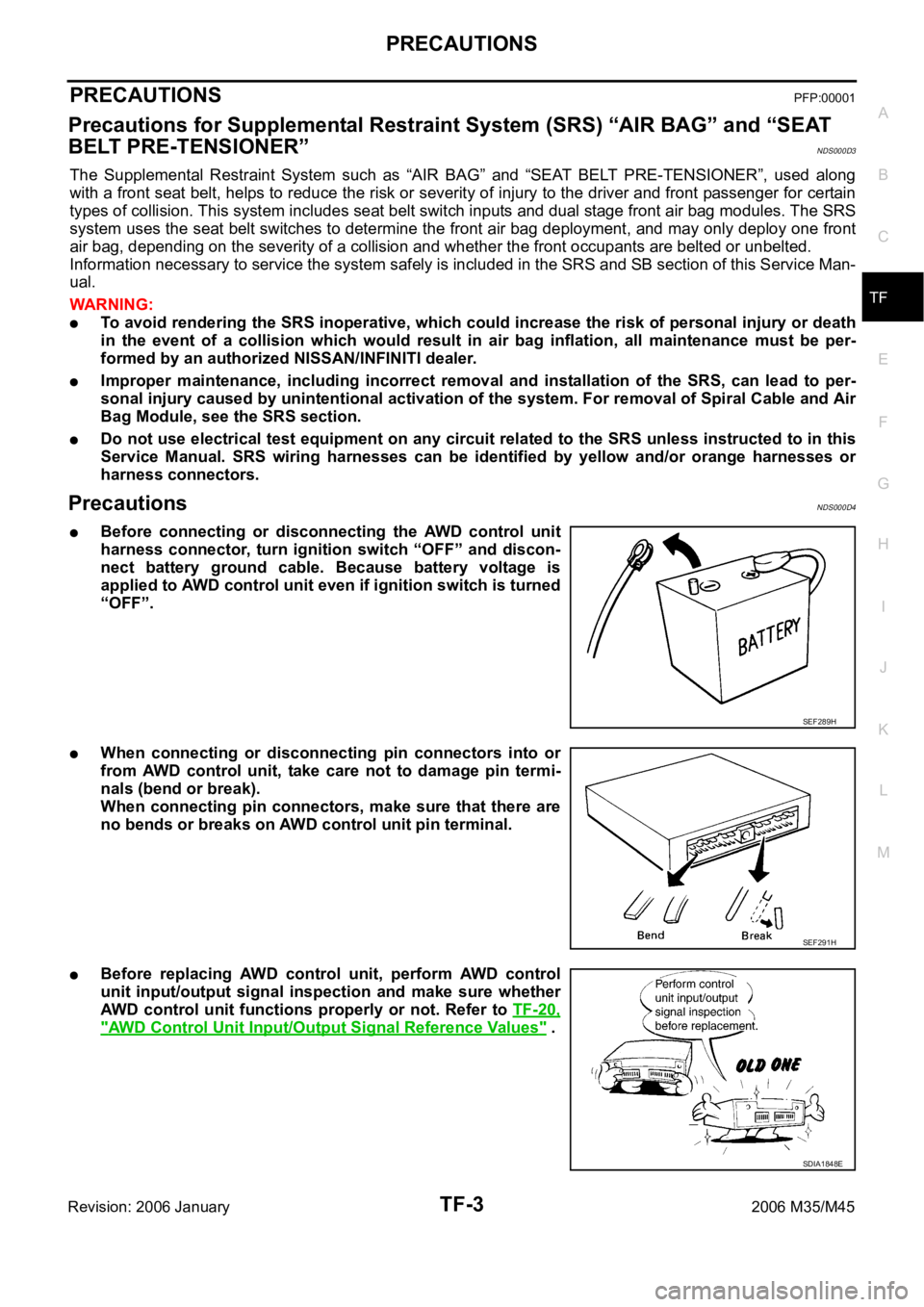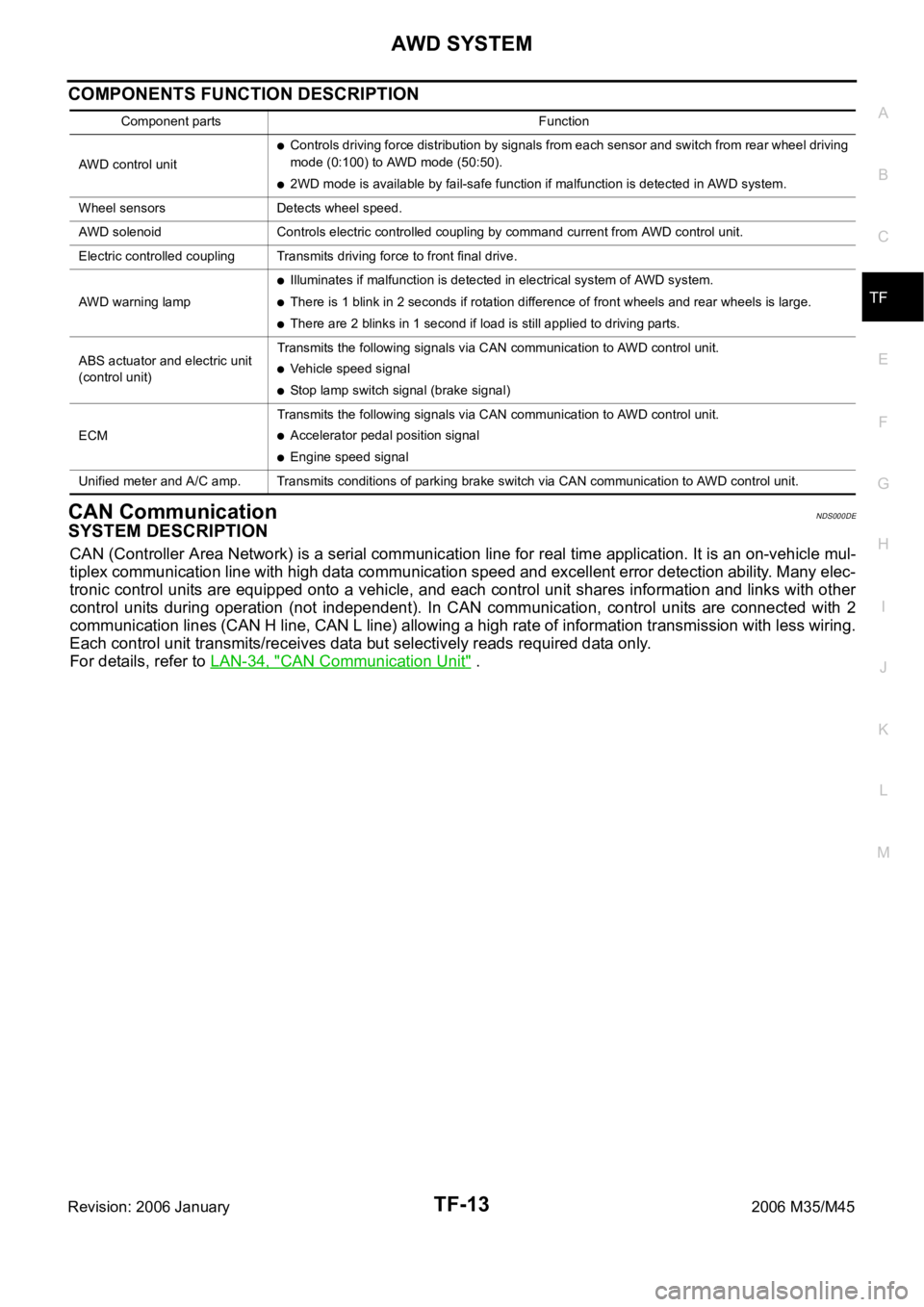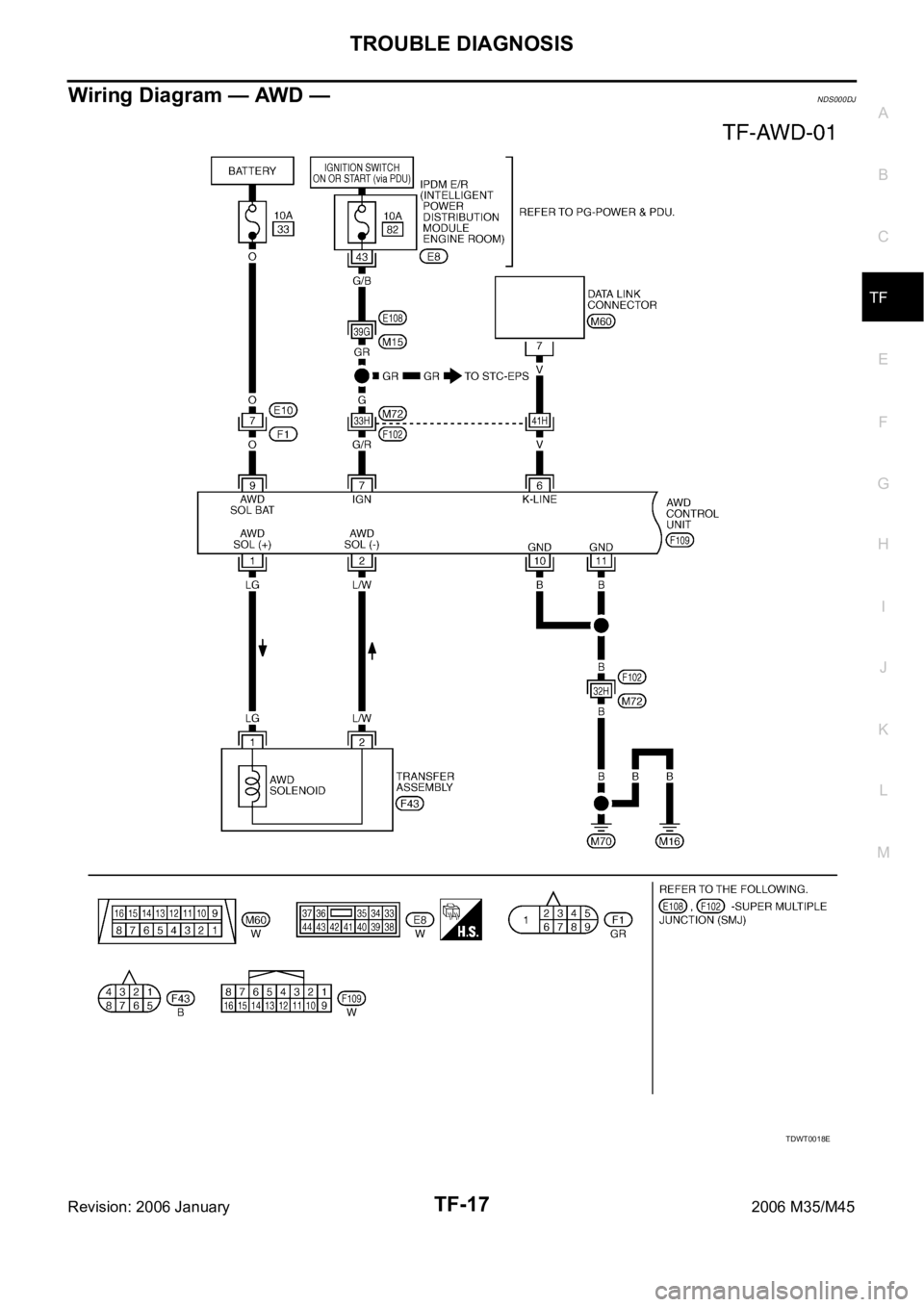2006 INFINITI M35 wiring
[x] Cancel search: wiringPage 5421 of 5621
![INFINITI M35 2006 Factory Service Manual STC-6
[EPS]
TROUBLE DIAGNOSIS
Revision: 2006 January2006 M35/M45
Wiring Diagram — EPS — NGS000DZ
TGWT0023E INFINITI M35 2006 Factory Service Manual STC-6
[EPS]
TROUBLE DIAGNOSIS
Revision: 2006 January2006 M35/M45
Wiring Diagram — EPS — NGS000DZ
TGWT0023E](/manual-img/42/57023/w960_57023-5420.png)
STC-6
[EPS]
TROUBLE DIAGNOSIS
Revision: 2006 January2006 M35/M45
Wiring Diagram — EPS — NGS000DZ
TGWT0023E
Page 5436 of 5621
![INFINITI M35 2006 Factory Service Manual TROUBLE DIAGNOSIS
STC-21
[RAS]
C
D
E
F
H
I
J
K
L
MA
B
STC
Revision: 2006 January2006 M35/M45
Wiring Diagram — RAS —NGS000EE
TGWT0026E INFINITI M35 2006 Factory Service Manual TROUBLE DIAGNOSIS
STC-21
[RAS]
C
D
E
F
H
I
J
K
L
MA
B
STC
Revision: 2006 January2006 M35/M45
Wiring Diagram — RAS —NGS000EE
TGWT0026E](/manual-img/42/57023/w960_57023-5435.png)
TROUBLE DIAGNOSIS
STC-21
[RAS]
C
D
E
F
H
I
J
K
L
MA
B
STC
Revision: 2006 January2006 M35/M45
Wiring Diagram — RAS —NGS000EE
TGWT0026E
Page 5446 of 5621
![INFINITI M35 2006 Factory Service Manual TROUBLE DIAGNOSIS
STC-31
[RAS]
C
D
E
F
H
I
J
K
L
MA
B
STC
Revision: 2006 January2006 M35/M45
Diagnosis Procedure with Self-Diagnosis Function (Without CONSULT- I I )NGS000EL
DESCRIPTION
If a malfunc INFINITI M35 2006 Factory Service Manual TROUBLE DIAGNOSIS
STC-31
[RAS]
C
D
E
F
H
I
J
K
L
MA
B
STC
Revision: 2006 January2006 M35/M45
Diagnosis Procedure with Self-Diagnosis Function (Without CONSULT- I I )NGS000EL
DESCRIPTION
If a malfunc](/manual-img/42/57023/w960_57023-5445.png)
TROUBLE DIAGNOSIS
STC-31
[RAS]
C
D
E
F
H
I
J
K
L
MA
B
STC
Revision: 2006 January2006 M35/M45
Diagnosis Procedure with Self-Diagnosis Function (Without CONSULT- I I )NGS000EL
DESCRIPTION
If a malfunction is detected in the system, the RAS warning lamp turns on and indicates the malfunction. At
that time, fail-safe activates, and then stops the function.
SELF-DIAGNOSIS PROCEDURE
1. Start engine.
2. Turn steering wheel left and right at 20
or more and 5 times or more within 10 seconds. And then depress
the service brake 5 times or more.
3. RAS warning lamp blinks (displays normal/malfunction).
SELF-DIAGNOSIS DISPLAY
RAS warning lamp blinks and displays the self-diagnostic results.
Only DTCs are displayed as the pattern shown in the figure, and
then repeat the display.
If all items are normal, RAS warning lamp blinks at 4 Hz cycle.
SELF-DIAGNOSIS DISPLAY ITEMS
HOW TO ERASE SELF-DIAGNOSIS
If there is the history data for when the fail-safe has activated in the past, erase the memory with CONSULT-II.
Refer to STC-29, "
How to Erase Self-Diagnostic Results" .
CAN CommunicationNGS000EM
SYSTEM DESCRIPTION
CAN (Controller Area Network) is a serial communication line for real time application. It is an on-vehicle mul-
tiplex communication line with high data communication speed and excellent error detection ability. Many elec-
tronic control units are equipped onto a vehicle, and each control unit shares information and links with other
control units during operation (not independent). In CAN communication, control units are connected with 2
communication lines (CAN H line, CAN L line) allowing a high rate of information transmission with less wiring.
Each control unit transmits/receives data but selectively reads required data only. Refer to LAN-34, "
CAN
Communication Unit" .
SGIA1243E
DTC (warning lamp blinks) Diagnosis item Inspection item
11 RAS control unitSTC-35, "
Inspection 1: RAS Control Unit Malfunction"
12 Motor power supplySTC-35, "Inspection 2: Motor Power Supply System"
13 Motor outputSTC-37, "Inspection 3: RAS Motor Output Malfunction"
21 Vehicle speed signalSTC-38, "Inspection 4: Vehicle Speed Signal"
22 Steering angle signalSTC-38, "Inspection 5: Steering Angle Signal Malfunction"
24 Rear wheel steering angle (main)STC-40, "Inspection 6: Rear Main Signal and Rear Sub Signal
Malfunction"
25 Rear wheel steering angle (sub)STC-40, "Inspection 6: Rear Main Signal and Rear Sub Signal
Malfunction"
26 VDCSTC-42, "Inspection 7: VDC Malfunction"
33 Engine speed signalSTC-43, "Inspection 8: Engine Speed Signal Malfunction"
Page 5466 of 5621

TF-1
TRANSFER
D DRIVELINE/AXLE
CONTENTS
C
E
F
G
H
I
J
K
L
M
SECTION TF
A
B
TF
Revision: 2006 January2006 M35/M45
TRANSFER
PRECAUTIONS .......................................................... 3
Precautions for Supplemental Restraint System
(SRS) “AIR BAG” and “SEAT BELT PRE-TEN-
SIONER” .................................................................. 3
Precautions .............................................................. 3
Service Notice or Precautions .................................. 4
PREPARATION ........................................................... 5
Special Service Tools ............................................... 5
Commercial Service Tools ........................................ 7
NOISE, VIBRATION AND HARSHNESS (NVH)
TROUBLESHOOTING ................................................ 8
NVH Troubleshooting Chart ..................................... 8
TRANSFER FLUID ..................................................... 9
Replacement ............................................................ 9
DRAINING ............................................................. 9
FILLING ................................................................. 9
Inspection ................................................................. 9
FLUID LEAKAGE AND FLUID LEVEL .................. 9
AWD SYSTEM .......................................................... 10
Power Transfer Diagram ........................................ 10
System Description ................................................ 10
DESCRIPTION .................................................... 10
ELECTRIC CONTROLLED COUPLING .............. 11
AWD CONTROL UNIT ......................................... 11
AWD WARNING LAMP ....................................... 12
System Diagram ..................................................... 12
COMPONENTS FUNCTION DESCRIPTION ..... 13
CAN Communication .............................................. 13
SYSTEM DESCRIPTION .................................... 13
TROUBLE DIAGNOSIS ............................................ 14
Fail-Safe Function .................................................. 14
How to Perform Trouble Diagnosis ........................ 14
BASIC CONCEPT ............................................... 14
Location of Electrical Parts ..................................... 15
Circuit Diagram ...................................................... 16
Wiring Diagram — AWD — .................................... 17
Trouble Diagnosis Chart for Symptoms ................. 20
AWD Control Unit Input/Output Signal Reference
Values .................................................................... 20AWD CONTROL UNIT INSPECTION TABLE ..... 20
CONSULT-II Function (ALL MODE AWD/4WD) ..... 21
FUNCTION .......................................................
... 21
CONSULT-II SETTING PROCEDURE ................ 22
SELF-DIAG RESULT MODE ............................... 22
DATA MONITOR MODE ...................................... 24
ACTIVE TEST MODE ......................................... 25
AWD CONTROL UNIT PART NUMBER ............. 25
TROUBLE DIAGNOSIS FOR SYSTEM .................... 26
Power Supply Circuit for AWD Control Unit ............ 26
CONSULT-II REFERENCE VALUE IN DATA
MONITOR MODE ................................................ 26
DIAGNOSTIC PROCEDURE .............................. 26
AWD Control Unit ................................................... 27
DIAGNOSTIC PROCEDURE .............................. 27
ABS System ........................................................... 27
DIAGNOSTIC PROCEDURE .............................. 27
AWD Solenoid ........................................................ 28
CONSULT-II REFERENCE VALUE IN DATA
MONITOR MODE ................................................ 28
DIAGNOSTIC PROCEDURE .............................. 28
COMPONENT INSPECTION .............................. 30
AWD Actuator Relay ............................................... 31
CONSULT-II REFERENCE VALUE IN DATA
MONITOR MODE ................................................ 31
DIAGNOSTIC PROCEDURE .............................. 31
Engine Control Signal ............................................. 32
DIAGNOSTIC PROCEDURE .............................. 32
CAN Communication Line ...................................... 32
DIAGNOSTIC PROCEDURE .............................. 32
TROUBLE DIAGNOSIS FOR SYMPTOMS .............. 33
AWD Warning Lamp Does Not Turn ON When The
Ignition Switch Is Turned to ON .............................. 33
DIAGNOSTIC PROCEDURE .............................. 33
AWD Warning Lamp Does Not Turn OFF Several
Seconds after Engine Started ................................. 33
DIAGNOSTIC PROCEDURE .............................. 33
Heavy Tight-Corner Braking Symptom Occurs
When The Vehicle Is Driven and The Steering Wheel
Is Turned Fully to Either Side after The Engine Is
Page 5468 of 5621

PRECAUTIONS
TF-3
C
E
F
G
H
I
J
K
L
MA
B
TF
Revision: 2006 January2006 M35/M45
PRECAUTIONSPFP:00001
Precautions for Supplemental Restraint System (SRS) “AIR BAG” and “SEAT
BELT PRE-TENSIONER”
NDS000D3
The Supplemental Restraint System such as “AIR BAG” and “SEAT BELT PRE-TENSIONER”, used along
with a front seat belt, helps to reduce the risk or severity of injury to the driver and front passenger for certain
types of collision. This system includes seat belt switch inputs and dual stage front air bag modules. The SRS
system uses the seat belt switches to determine the front air bag deployment, and may only deploy one front
air bag, depending on the severity of a collision and whether the front occupants are belted or unbelted.
Information necessary to service the system safely is included in the SRS and SB section of this Service Man-
ual.
WAR NING :
To avoid rendering the SRS inoperative, which could increase the risk of personal injury or death
in the event of a collision which would result in air bag inflation, all maintenance must be per-
formed by an authorized NISSAN/INFINITI dealer.
Improper maintenance, including incorrect removal and installation of the SRS, can lead to per-
sonal injury caused by unintentional activation of the system. For removal of Spiral Cable and Air
Bag Module, see the SRS section.
Do not use electrical test equipment on any circuit related to the SRS unless instructed to in this
Service Manual. SRS wiring harnesses can be identified by yellow and/or orange harnesses or
harness connectors.
PrecautionsNDS000D4
Before connecting or disconnecting the AWD control unit
harness connector, turn ignition switch “OFF” and discon-
nect battery ground cable. Because battery voltage is
applied to AWD control unit even if ignition switch is turned
“OFF”.
When connecting or disconnecting pin connectors into or
from AWD control unit, take care not to damage pin termi-
nals (bend or break).
When connecting pin connectors, make sure that there are
no bends or breaks on AWD control unit pin terminal.
Before replacing AWD control unit, perform AWD control
unit input/output signal inspection and make sure whether
AWD control unit functions properly or not. Refer to TF-20,
"AWD Control Unit Input/Output Signal Reference Values" .
SEF289H
SEF291H
SDIA1848E
Page 5478 of 5621

AWD SYSTEM
TF-13
C
E
F
G
H
I
J
K
L
MA
B
TF
Revision: 2006 January2006 M35/M45
COMPONENTS FUNCTION DESCRIPTION
CAN CommunicationNDS000DE
SYSTEM DESCRIPTION
CAN (Controller Area Network) is a serial communication line for real time application. It is an on-vehicle mul-
tiplex communication line with high data communication speed and excellent error detection ability. Many elec-
tronic control units are equipped onto a vehicle, and each control unit shares information and links with other
control units during operation (not independent). In CAN communication, control units are connected with 2
communication lines (CAN H line, CAN L line) allowing a high rate of information transmission with less wiring.
Each control unit transmits/receives data but selectively reads required data only.
For details, refer to LAN-34, "
CAN Communication Unit" .
Component parts Function
AWD control unit
Controls driving force distribution by signals from each sensor and switch from rear wheel driving
mode (0:100) to AWD mode (50:50).
2WD mode is available by fail-safe function if malfunction is detected in AWD system.
Wheel sensors Detects wheel speed.
AWD solenoid Controls electric controlled coupling by command current from AWD control unit.
Electric controlled coupling Transmits driving force to front final drive.
AWD warning lamp
Illuminates if malfunction is detected in electrical system of AWD system.
There is 1 blink in 2 seconds if rotation difference of front wheels and rear wheels is large.
There are 2 blinks in 1 second if load is still applied to driving parts.
ABS actuator and electric unit
(control unit)Transmits the following signals via CAN communication to AWD control unit.
Vehicle speed signal
Stop lamp switch signal (brake signal)
ECMTransmits the following signals via CAN communication to AWD control unit.
Accelerator pedal position signal
Engine speed signal
Unified meter and A/C amp. Transmits conditions of parking brake switch via CAN communication to AWD control unit.
Page 5482 of 5621

TROUBLE DIAGNOSIS
TF-17
C
E
F
G
H
I
J
K
L
MA
B
TF
Revision: 2006 January2006 M35/M45
Wiring Diagram — AWD —NDS000DJ
TDWT0018E
Page 5526 of 5621

WT-1
ROAD WHEELS & TIRES
E SUSPENSION
CONTENTS
C
D
F
G
H
I
J
K
L
M
SECTION WT
A
B
WT
Revision: 2006 January2006 M35/M45
ROAD WHEELS & TIRES
PRECAUTIONS .......................................................... 3
Precautions .............................................................. 3
PREPARATION ........................................................... 4
Special Service Tools [SST] ..................................... 4
Commercial Service Tools ........................................ 4
NOISE, VIBRATION AND HARSHNESS (NVH)
TROUBLESHOOTING ................................................ 5
NVH Troubleshooting Chart ..................................... 5
ROAD WHEEL ............................................................ 6
Inspection ................................................................. 6
ALUMINUM WHEEL ............................................. 6
STEEL WHEEL ..................................................... 6
ROAD WHEEL TIRE ASSEMBLY .............................. 7
Balancing Wheels (Bonding Weight Type) ............... 7
REMOVAL ........................................................
..... 7
WHEEL BALANCE ADJUSTMENT ...................... 7
Rotation .................................................................... 8
LOW TIRE PRESSURE WARNING SYSTEM ............ 9
System Components ................................................ 9
System Description .................................................. 9
TRANSMITTER ..................................................... 9
RECEIVER .......................................................
... 10
LOW TIRE PRESSURE WARNING CONTROL
UNIT .................................................................... 10
LOW TIRE PRESSURE WARNING LAMP ......... 10
DISPLAY UNIT ..................................................... 11
CAN COMMUNICATION .......................................... 12
System Description ................................................ 12
TROUBLE DIAGNOSES .......................................... 13
How to Perform Trouble Diagnoses ....................... 13
BASIC CONCEPT ............................................... 13
Schematic .............................................................. 14
Wiring Diagram — T/WARN — .............................. 15
Control Unit Input/Output Signal Standard ............. 18
ID Registration Procedure ...................................... 19
ID REGISTRATION WITH ACTIVATION TOOL ... 19
ID REGISTRATION WITHOUT ACTIVATION
TOOL .................................................................. 20
Transmitter Wake Up Operation ............................. 21
WITH TRANSMITTER ACTIVATION TOOL ........ 21CONSULT-II Function (AIR PRESSURE MONI-
TOR) ....................................................................... 21
FUNCTION .......................................................
... 21
CONSULT-II SETTING PROCEDURE ................ 21
WORK SUPPORT MODE ................................... 22
SELF-DIAG RESULT MODE ............................... 22
DATA MONITOR MODE ...................................... 23
ACTIVE TEST MODE ......................................... 23
LOW TIRE PRESSURE WARNING CONTROL
UNIT PART NUMBER ......................................... 24
Diagnosis Procedure with Warning Lamp Function
(Without CONSULT-II) ............................................ 24
DESCRIPTION .................................................... 24
FUNCTION .......................................................
... 24
LOW TIRE PRESSURE WARNING LAMP DIAG-
NOSTIC CHART .................................................. 24
How to Perform Trouble Diagnosis for Quick and
Accurate Repair ...................................................... 26
INTRODUCTION ................................................. 26
WORK FLOW ...................................................... 26
Preliminary Check .................................................. 27
Trouble Diagnosis Chart ......................................... 28
SELF-DIAGNOSIS .............................................. 28
DIAGNOSIS CHART BY SYMPTOM .................. 29
TROUBLE DIAGNOSIS FOR SELF-DIAGNOSTIC
ITEMS ........................................................................ 30
Inspection 1: Transmitter no Data ........................... 30
MALFUNCTION CODE NO. 21, 22, 23, 24 ......... 30
Inspection 2: Receiver Data Error .......................... 31
MALFUNCTION CODE NO. 25, 26, 27, 28 ......... 31
Inspection 3: Transmitter Pressure Data Error ....... 32
MALFUNCTION CODE NO. 35, 36, 37, 38 ......... 32
Inspection 4: Transmitter Function Code Error ....... 32
MALFUNCTION CODE NO. 41, 42, 43, 44 ......... 32
Inspection 5: Transmitter Battery Voltage Low ....... 33
MALFUNCTION CODE NO. 45, 46, 47, 48 ......... 33
Inspection 6: Receiver ID No Registration .............. 33
MALFUNCTION CODE NO. 51 ........................... 33
Inspection 7: Vehicle Speed Signal ........................ 34